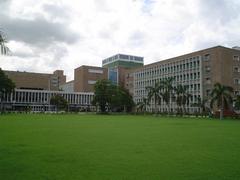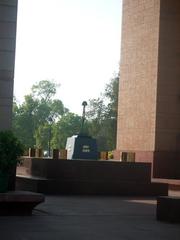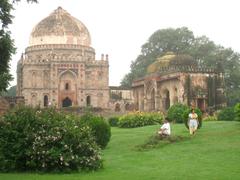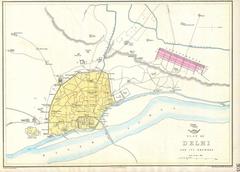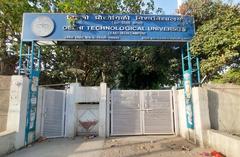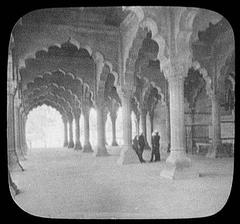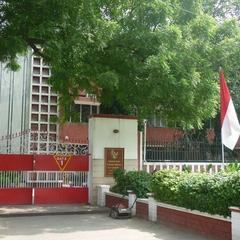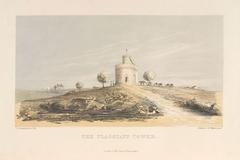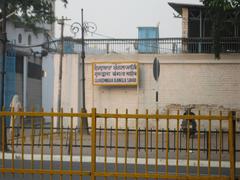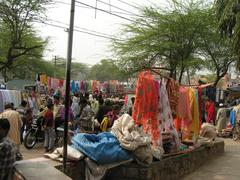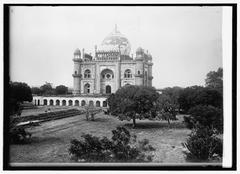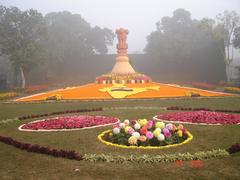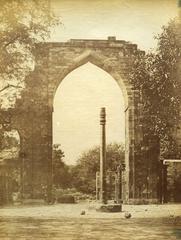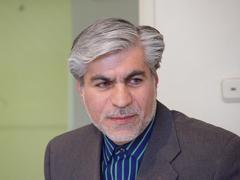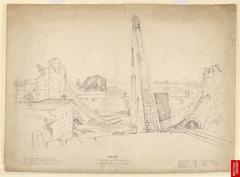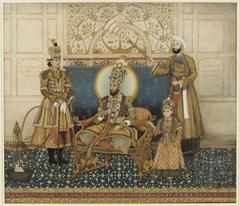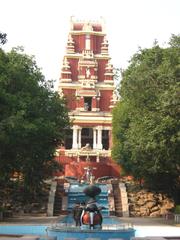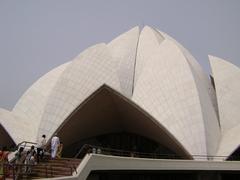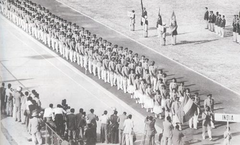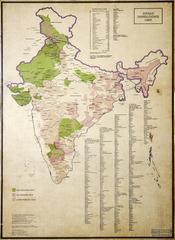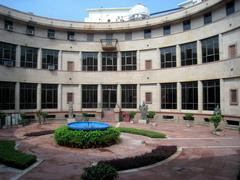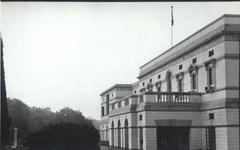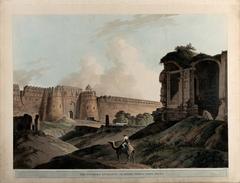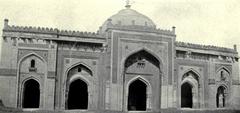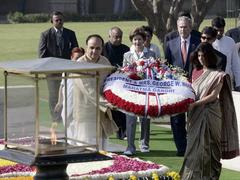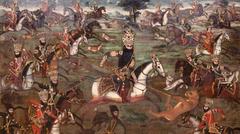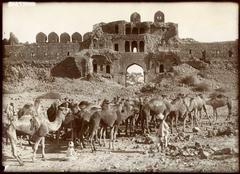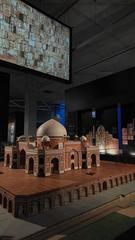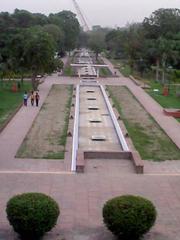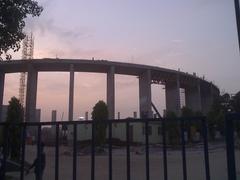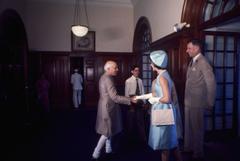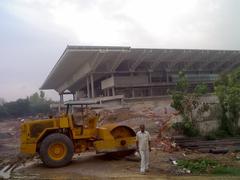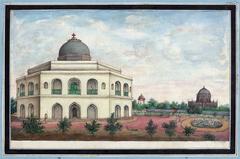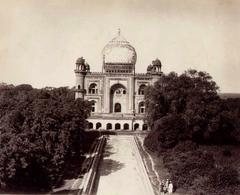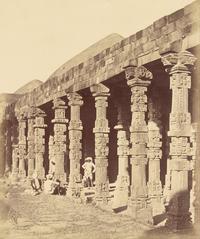Statue of Mahatma Gandhi: Visiting Hours, Tickets, and Complete Guide to New Delhi’s Iconic Landmark
Date: 14/06/2025
Introduction
The Statue of Mahatma Gandhi, now located at Prerna Sthal within the Parliament House Complex in New Delhi, stands as a powerful symbol of India’s enduring commitment to non-violence, democracy, and civic engagement. Revered as the “Father of the Nation,” Gandhi’s legacy is immortalized in this 16-foot bronze sculpture, designed by Ram V. Sutar, which depicts him in a meditative, cross-legged posture—a visual representation of introspection and peaceful resistance (Suzanne Wanders Delhi; Wikipedia: Parliament House, New Delhi; DBpedia: Statue of Mahatma Gandhi, Parliament of India).
In 2024, the statue was relocated to Prerna Sthal (“Place of Inspiration”) to enhance accessibility, consolidate national memorials, and offer educational features such as QR codes and interactive panels (Hindustan Times; India Today). This guide provides a detailed overview of the statue’s history, cultural significance, visiting hours, tickets, accessibility, and practical tips for visitors.
Table of Contents
- Historical Significance
- Artistic and Symbolic Features
- Civic and Political Importance
- Prerna Sthal: The New Home
- Visiting Hours and Tickets
- Entry Protocols and Accessibility
- Guided Tours and Visitor Experience
- Nearby Attractions and Travel Tips
- Frequently Asked Questions (FAQ)
- Conclusion
- References
Historical Significance
Gandhi’s Enduring Legacy
Mahatma Gandhi led India’s freedom struggle through nonviolent resistance (satyagraha) and became a global icon for civil rights. His assassination in 1948 left a profound impact, and his teachings continue to inspire movements worldwide (Suzanne Wanders Delhi). Memorials across India—including the Parliament House—honor his contributions.
The Parliament Setting
The Parliament House (Sansad Bhavan) is the seat of India’s legislature (Wikipedia: Parliament House, New Delhi). Placing Gandhi’s statue here emphasizes his central role in shaping India’s Constitution and democratic ethos.
Inauguration and Evolution
The statue was inaugurated in 1993, decades after independence, as a tribute to Gandhi’s principles and their ongoing relevance in public life (DBpedia: Statue of Mahatma Gandhi, Parliament of India). Over time, it has become a site for tributes, remembrance, and peaceful protest.
Artistic and Symbolic Features
Design and Dimensions
Sculpted by Ram V. Sutar, the 16-foot bronze statue captures Gandhi in a contemplative pose, underscoring humility and introspection (DBpedia: Statue of Mahatma Gandhi, Parliament of India). The use of bronze ensures durability and gravitas. Sutar’s work is known for its realism and emotional resonance—he also sculpted the world’s tallest statue, the Statue of Unity.
Iconography
Gandhi is depicted cross-legged, reflecting his meditative nature and commitment to nonviolence. The simplicity of the design mirrors his ascetic lifestyle and advocacy for humility.
Context in Public Art
The Gandhi statue at Parliament is part of a wider tradition of commemorative statuary in India, with similar monuments at Raj Ghat and across the world (Times of India: Statues of Gandhi Across the World).
Civic and Political Importance
Site of Peaceful Protest
Since its installation, the statue has served as a gathering point for Members of Parliament and civil society, particularly for sit-ins and silent demonstrations, reflecting Gandhi’s own methods (DBpedia: Statue of Mahatma Gandhi, Parliament of India). Protesting at Gandhi’s feet invokes his legacy of nonviolent dissent.
National and International Recognition
Dignitaries, citizens, and tourists pay homage here on important dates such as Gandhi Jayanti (October 2). The site has witnessed commemorations and official ceremonies, reinforcing its role in India’s public memory (The Delhi Tours: Raj Ghat).
Relocation and Debate
The 2024 relocation to Prerna Sthal sparked debate, with some arguing it limited protest visibility, and others emphasizing improved accessibility and educational features (News18; Hindustan Times).
Prerna Sthal: The New Home
Prerna Sthal is a landscaped garden between the old Parliament and Parliament Library buildings, now housing statues of Gandhi, Dr. B.R. Ambedkar, Chhatrapati Shivaji Maharaj, and other national figures (Hindustan Times). The area provides:
- Unified memorial space for reflection.
- QR codes and digital panels for interactive learning (ETV Bharat).
- Wheelchair-accessible paths and serene gardens.
Visiting Hours and Tickets
- Visiting Hours: Prerna Sthal is open Monday through Saturday, 9:00 AM–5:30 PM. During parliamentary sessions or special events, access may be restricted; check official sources before visiting (ETV Bharat).
- Entry Fee: Entry is free. However, visitors must obtain prior permission or be part of an authorized guided tour due to security protocols.
- Tickets: Not required, but advance registration and security clearance are mandatory.
Entry Protocols and Accessibility
- ID Requirements: Carry valid government-issued ID. Foreign nationals must present passport and visa.
- Security: Thorough screening, including bag checks and metal detectors, is mandatory.
- Dress Code: Wear modest, respectful attire.
- Accessibility: The area is wheelchair accessible. Contact visitor services in advance for special needs (Audiala).
Guided Tours and Visitor Experience
- Guided Tours: Highly recommended for context and access. Book in advance via the Parliament of India’s website or through your Member of Parliament (for Indian citizens) or embassy (for foreign nationals).
- Duration: Tours typically last 1–2 hours and cover Prerna Sthal and other key Parliament areas.
- Amenities: Battery-operated vehicles, restrooms, and drinking water are available. Photography is permitted in designated areas, with restrictions elsewhere.
Nearby Attractions and Travel Tips
- Raj Ghat: Gandhi’s cremation memorial (Suzanne Wanders Delhi; Delhi Metro Times).
- Gandhi Smriti: Museum at Gandhi’s place of martyrdom (Audiala).
- India Gate & Rashtrapati Bhavan: Iconic landmarks within easy reach.
- Transport: Nearest Metro stations are Central Secretariat and Patel Chowk. No private vehicles allowed inside; use public transport or park outside and walk/battery vehicle to the site.
Frequently Asked Questions (FAQ)
Q1: What are the visiting hours?
A1: Monday–Saturday, 9:00 AM–5:30 PM. Confirm in advance during parliamentary sessions or national holidays.
Q2: Is there an entry fee?
A2: No, entry is free, but prior permission or guided tour participation is required.
Q3: Are guided tours available?
A3: Yes, and they are highly recommended for context and access.
Q4: Is the site wheelchair accessible?
A4: Yes, with ramps and accessible paths.
Q5: Can I take photographs?
A5: Permitted in designated areas at Prerna Sthal with official approval.
Conclusion
The Statue of Mahatma Gandhi at Prerna Sthal is not only a site of national remembrance but also a living testament to India’s ongoing journey toward peace, justice, and democracy. With clear visiting protocols, educational features, and proximity to other major landmarks, it promises an enriching experience for every visitor. Plan ahead, respect the site’s solemnity, and explore the broader heritage of New Delhi for a deeper understanding of Gandhi’s enduring influence.
For continuous updates, guided tours, and more heritage explorations, download the Audiala app and follow our social media channels.
References
- Suzanne Wanders Delhi: Raj Ghat, A Local Guide to Delhi’s Gandhi Memorial
- Wikipedia: Parliament House, New Delhi
- DBpedia: Statue of Mahatma Gandhi, Parliament of India
- Times of India: Statues of Gandhi Across the World
- The Delhi Tours: Raj Ghat
- Economic Times: New Parliament’s Architectural Elements
- News18: Why Mahatma Gandhi, B.R. Ambedkar Statues Have Been Relocated
- Hindustan Times: Iconic Gandhi Statue Relocated to Prerna Sthal
- India Today: Prerna Sthal Opens; Congress Slams Government
- ETV Bharat: Discussions with Stakeholders
- BBC News: Gandhi’s Legacy and Contemporary Debates
- Tour My India: Raj Ghat Mahatma Gandhi Memorial
- Delhi Metro Times: Raj Ghat
- Audiala: Gandhi Smriti, New Delhi
- Wikipedia: Statue of Mahatma Gandhi, Parliament of India

